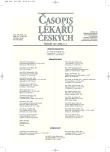-
Medical journals
- Career
Purkynje Fibers of the Heart Conduction System – History and the Present Time
Authors: O. Eliška
Authors‘ workplace: Anatomický ústav 1. LF UK, Praha
Published in: Čas. Lék. čes. 2006; 145: 329-335
Category: History of Medicine
Overview
It has been 160 years now since Purkynje published the finding of conduction fibers in the heart in Archiv f. Anatomie u. Physiologie and it has been 166 years since his publication in polish version. Already during Purkynje’s life, some anatomists had solved the morphology of these fibers but nobody at that time knew of what great physiological and medical importance this discovery would be for medicine. It was seen as late as in the 20th century and in contemporary times. Purkynje’s work indicated the cascade of these discoveries, which were leading in the beginning of the previous century to the formulation of the basic scheme of the conduction system. Purkynje fibers or Purkynje cardiomyocytes are part of the whole complex of the cardiac conduction system which today is classified as specific heart muscle tissue, being responsible for the generation of the heart impulses. From the point of view of ultrastructural composition, the cells of different parts of the cardiac conduction systém are partly similar. In contrast to the heart contractile cardiomyocytes, the cells of the cardiac conduction systém including Purkynje fibers have a small amount of myofibrils,small mitochondrias, light cytoplasm and a higher glycogen content, but no T-tubular system. They can be detected with some morphological methods. Nevertheless the cells of the conduction system are not completely uniform. They differ in size, number of nexuses-gaps and intercalar discs in individual parts of the conduction systém. Nevertheless, these specialized cells work as a whole – unit. Nowadays, the morphology research of all the parts of cardiac conduction system, including Purkynje fibers, is focused on ultrastructural, histochemical and genetical problems. The question is, wheather with future gene/cell therapy disturbances of the conduction system such as arrythmias, can be prevented and cured by replacing the electrical pacemakers with biological ones. If Jan Evangelista Purkynje lived today, he would be surprised but surely delighted with the high degree of research concerning his discovery and its clinical application.
Key words:
Purkynje fibers, morphology, history, present time.
Labels
Addictology Allergology and clinical immunology Angiology Audiology Clinical biochemistry Dermatology & STDs Paediatric gastroenterology Paediatric surgery Paediatric cardiology Paediatric neurology Paediatric ENT Paediatric psychiatry Paediatric rheumatology Diabetology Pharmacy Vascular surgery Pain management Dental Hygienist
Article was published inJournal of Czech Physicians

-
All articles in this issue
- Therapy of Patients with Heart Failure – Do we Owe Anything to Our Patients?
- Long-lasting Cardiostimulation in the Treatment of Heart Failure
- Contemporary Prospects for the Diagnostics and Treatment of the Chronic Pulmonary Hypertension
- Current Approach to the Diagnostics and Therapy of Acute Coronary Syndromes
- Role of Doppler Echocardiography in the Diagnostics and Therapy of Hypertrophic Cardiomyopathy
- Mortality Downtrend Stopped During Previous Years
- Aristoteles Redivivus or Small Repetitorium of Aristotelian Methodology Regarding Problems of Psychosomatic Medicine
- Chance for Patients with Rare Diseases – „Orphan” Medicinal Products
- EBV Quantification in Children Undergoing Allogeneic Hematopoietic Stem Cell Transplantation
- Pulmonary Endarterectomy – The Surgical Treatment of Chronic Thromboembolic Pulmonary Hypertension
- Paternal Smoking and Exposure of Pre-school Children to Tobacco Smoke
- Methylene Blue in the Therapy of Vasoplegic Syndrome after Cardiac Surgery Procedure
- Larva migrans cutanea
- Purkynje Fibers of the Heart Conduction System – History and the Present Time
- Journal of Czech Physicians
- Journal archive
- Current issue
- Online only
- About the journal
Most read in this issue- Purkynje Fibers of the Heart Conduction System – History and the Present Time
- Larva migrans cutanea
- Pulmonary Endarterectomy – The Surgical Treatment of Chronic Thromboembolic Pulmonary Hypertension
- Long-lasting Cardiostimulation in the Treatment of Heart Failure
Login#ADS_BOTTOM_SCRIPTS#Forgotten passwordEnter the email address that you registered with. We will send you instructions on how to set a new password.
- Career

